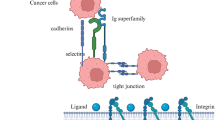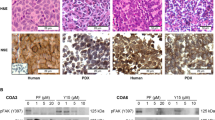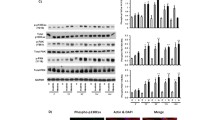Abstract
Purpose
The cell adhesion/recognition protein L1CAM (L1; CD171) has previously been shown to act through integrin, focal adhesion kinase (FAK) and fibroblast growth factor receptor (FGFR) signaling pathways to increase the motility and proliferation of glioblastoma cells in an autocrine/paracrine manner. Here, we investigated the effects of clinically relevant small-molecule inhibitors of the integrin, FAK and FGFR signaling pathways on glioblastoma-derived cells to determine their effectiveness and selectivity for diminishing L1-mediated stimulation.
Methods
The effects of the FGFR inhibitor PD173074, the FAK inhibitors PF431396 and Y15 and the αvβ3/αvβ5 integrin inhibitor cilengitide were assessed in L1-positive and L1-negative variants of the human glioblastoma-derived cell lines T98G and U-118 MG. Their motility and proliferation were quantified using time-lapse microscopy and DNA content/cell cycle analyses, respectively.
Results
The application of all four inhibitors resulted in reductions in L1-mediated motility and proliferation rates of L1-positive glioblastoma-derived cells, down to the level of L1-negative cells when used at nanomolar concentrations, whereas no or much smaller reductions in these rates were obtained in L1-negative cells. In addition, we found that single inhibitor treatment resulted in maximum effects (i.e., combinations of FAK or integrin inhibitors with the FGFR inhibitor were rarely more effective). These results suggest that FAK may act as a point of convergence between the integrin and FGFR signaling pathways stimulated by L1 in these cells.
Conclusions
We here show for the first time that small-molecule inhibitors of FGFR, integrins and FAK effectively and selectively abolish L1-stimulated migration and proliferation of glioblastoma-derived cells. Our results suggest that these inhibitors have the potential to reduce the aggressiveness of high-grade gliomas expressing L1.





Similar content being viewed by others
References
P.Y. Wen, S. Kesari, Malignant gliomas in adults. N. Engl. J. Med. 359, 492–507 (2008)
F.B. Furnari, T. Fenton, R.M. Bachoo, A. Mukasa, J.M. Stommel, A. Stegh, W.C. Hahn, K.L. Ligon, D.N. Louis, C. Brennan, L. Chin, R.A. DePinho, W.K. Cavenee, Malignant astrocytic glioma: genetics, biology, and paths to treatment. Genes Dev. 21, 2683–2710 (2007)
S. Lee, S.R. Piccolo, K. Allen-Brady, Robust meta-analysis shows that glioma transcriptional subtyping complements traditional approaches. Cell. Oncol. 37, 317–329 (2014)
P. De Bonis, C. Anile, A. Pompucci, A. Fiorentino, M. Balducci, S. Chiesa, L. Lauriola, G. Maira, A. Mangiola, The influence of surgery on recurrence pattern of glioblastoma. Clin. Neurol. Neurosurg. 115, 37–43 (2013)
R. Stupp, W.P. Mason, M.J. van den Bent, M. Weller, B. Fisher, M.J.B. Taphoorn, K. Belanger, A.A. Brandes, C. Marosi, U. Bogdahn, J. Curschmann, R.C. Janzer, S.K. Ludwin, T. Gorlia, A. Allgeier, D. Lacombe, J.G. Cairncross, E. Eisenhauer, R.O. Mirimanoff, for the European Organisation for Research and Treatment of Cancer Brain Tumor and Radiotherapy Groups and the National Cancer Institute of Canada Clinical Trials Group, Radiotherapy plus concomitant and adjuvant temozolomide for glioblastoma. N. Engl. J. Med. 352, 987–996 (2005)
N.R. Smoll, K. Schaller, O.P. Gautschi, Long-term survival of patients with glioblastoma multiforme (GBM). J. Clin. Neurosci. Off. J. Neurosurg. Soc. Aust. 20, 670–675 (2013)
A. Faissner, D.B. Teplow, D. Kübler, G. Keilhauer, V. Kinzel, M. Schachner, Biosynthesis and membrane topography of the neural cell adhesion molecule L1. EMBO J. 4, 3105–3113 (1985)
M. Moos, R. Tacke, H. Scherer, D. Teplow, K. Früh, M. Schachner, Neural adhesion molecule L1 as a member of the immunoglobulin superfamily with binding domains similar to fibronectin. Nature 334, 701–703 (1988)
S. Chang, F.G. Rathjen, J.A. Raper, Extension of neurites on axons is impaired by antibodies against specific neural cell surface glycoproteins. J. Cell Biol. 104, 355–362 (1987)
G. Fischer, V. Künemund, M. Schachner, Neurite outgrowth patterns in cerebellar microexplant cultures are affected by antibodies to the cell surface glycoprotein L1. J. Neurosci. 6, 605–612 (1986)
G. Keilhauer, A. Faissner, M. Schachner, Differential inhibition of neurone-neurone, neurone-astrocyte and astrocyte-astrocyte adhesion by L1, L2 and N-CAM antibodies. Nature 316, 728–730 (1985)
J. Lindner, F.G. Rathjen, M. Schachner, L1 mono- and polyclonal antibodies modify cell migration in early postnatal mouse cerebellum. Nature 305, 427–430 (1983)
M. Conacci-Sorrell, A. Kaplan, S. Raveh, N. Gavert, T. Sakurai, A. Ben-Ze’ev, The shed ectodomain of Nr-CAM stimulates cell proliferation and motility, and confers cell transformation. Cancer Res. 65, 11605–11612 (2005)
P.M. Wood, M. Schachner, R.P. Bunge, Inhibition of Schwann cell myelination in vitro by antibody to the L1 adhesion molecule. J. Neurosci. 10, 3635–3645 (1990)
P. Liljelund, P. Ghosh, A.N. van den Pol, Expression of the neural axon adhesion molecule L1 in the developing and adult rat brain. J. Biol. Chem. 269, 32886–32895 (1994)
T. Maretzky, M. Schulte, A. Ludwig, S. Rose-John, C. Blobel, D. Hartmann, P. Altevogt, P. Saftig, K. Reiss, L1 is sequentially processed by two differently activated metalloproteases and presenilin/γ-secretase and regulates neural cell adhesion, cell migration, and neurite outgrowth. Mol. Cell. Biol. 25, 9040–9053 (2005)
M. Fogel, S. Mechtersheimer, M. Huszar, A. Smirnov, A. Abu-Dahi, W. Tilgen, J. Reichrath, T. Georg, P. Altevogt, P. Gutwein, L1 adhesion molecule (CD 171) in development and progression of human malignant melanoma. Cancer Lett. 189, 237–247 (2003)
M. Fogel, P. Gutwein, S. Mechtersheimer, S. Riedle, A. Stoeck, A. Smirnov, L. Edler, A. Ben-Arie, M. Huszar, P. Altevogt, L1 expression as a predictor of progression and survival in patients with uterine and ovarian carcinomas. Lancet 362, 869–875 (2003)
N. Gavert, M. Conacci-Sorrell, D. Gast, A. Schneider, P. Altevogt, T. Brabletz, A. Ben-Ze’ev, L1, a novel target of beta-catenin signaling, transforms cells and is expressed at the invasive front of colon cancers. J. Cell Biol. 168, 633–642 (2005)
M. Yang, S. Adla, M.K. Temburni, V.P. Patel, E.L. Lagow, O.A. Brady, J. Tian, M.I. Boulos, D.S. Galileo, Stimulation of glioma cell motility by expression, proteolysis, and release of the L1 neural cell recognition molecule. Cancer Cell Int. 9, 27 (2009)
Y. Li, D.S. Galileo, Soluble L1CAM promotes breast cancer cell adhesion and migration in vitro, but not invasion. Cancer Cell Int. 10, 34 (2010)
D. Chen, Z. Zeng, J. Yang, C. Ren, D. Wang, W. Wu, R. Xu, L1cam promotes tumor progression and metastasis and is an independent unfavorable prognostic factor in gastric cancer. J. Hematol. Oncol. 6, 43 (2013)
P. Gutwein, S. Mechtersheimer, S. Riedle, A. Stoeck, D. Gast, S. Joumaa, H. Zentgraf, M. Fogel, D.P. Altevogt, ADAM10-mediated cleavage of L1 adhesion molecule at the cell surface and in released membrane vesicles. FASEB J. 17, 292–294 (2003)
H. Kiefel, S. Bondong, J. Hazin, J. Ridinger, U. Schirmer, S. Riedle, P. Altevogt, L1CAM: a major driver for tumor cell invasion and motility. Cell Adhes. Migr. 6, 374–384 (2012)
M. Yang, Y. Li, K. Chilukuri, O.A. Brady, M.I. Boulos, J.C. Kappes, D.S. Galileo, L1 stimulation of human glioma cell motility correlates with FAK activation. J. Neurooncol. 105, 27–44 (2011)
V. Mohanan, M.K. Temburni, J.C. Kappes, D.S. Galileo, L1CAM stimulates glioma cell motility and proliferation through the fibroblast growth factor receptor. Clin. Exp. Metastasis 30, 507–520 (2013)
S. Mechtersheimer, P. Gutwein, N. Agmon-Levin, A. Stoeck, M. Oleszewski, S. Riedle, R. Postina, F. Fahrenholz, M. Fogel, V. Lemmon, P. Altevogt, Ectodomain shedding of L1 adhesion molecule promotes cell migration by autocrine binding to integrins. J. Cell Biol. 155, 661–673 (2001)
B. Felding-Habermann, S. Silletti, F. Mei, C.H. Siu, P.M. Yip, P.C. Brooks, D.A. Cheresh, T.E. O’Toole, M.H. Ginsberg, A.M. Montgomery, A single immunoglobulin-like domain of the human neural cell adhesion molecule L1 supports adhesion by multiple vascular and platelet integrins. J. Cell Biol. 139, 1567–1581 (1997)
A.M. Montgomery, J.C. Becker, C.H. Siu, V.P. Lemmon, D.A. Cheresh, J.D. Pancook, X. Zhao, R.A. Reisfeld, Human neural cell adhesion molecule L1 and rat homologue NILE are ligands for integrin alpha v beta 3. J. Cell Biol. 132, 475–485 (1996)
M. Oleszewski, S. Beer, S. Katich, C. Geiger, Y. Zeller, U. Rauch, P. Altevogt, Integrin and neurocan binding to L1 involves distinct Ig domains. J. Biol. Chem. 274, 24602–24610 (1999)
O. Ebeling, A. Duczmal, S. Aigner, C. Geiger, S. Schöllhammer, J.T. Kemshead, P. Möller, R. Schwartz-Albiez, P. Altevogt, L1 adhesion molecule on human lymphocytes and monocytes: expression and involvement in binding to alpha v beta 3 integrin. Eur. J. Immunol. 26, 2508–2516 (1996)
S. Blaess, R.A. Kammerer, H. Hall, Structural analysis of the sixth immunoglobulin-like domain of mouse neural cell adhesion molecule L1 and its interactions with alpha(v)beta3, alpha(IIb)beta3, and alpha5beta1 integrins. J. Neurochem. 71, 2615–2625 (1998)
M. Ruppert, S. Aigner, M. Hubbe, H. Yagita, P. Altevogt, The L1 adhesion molecule is a cellular ligand for VLA-5. J. Cell Biol. 131, 1881–1891 (1995)
A. Duczmal, S. Schöllhammer, S. Katich, O. Ebeling, R. Schwartz-Albiez, P. Altevogt, The L1 adhesion molecule supports alpha v beta 3-mediated migration of human tumor cells and activated T lymphocytes. Biochem. Biophys. Res. Commun. 232, 236–239 (1997)
J. Zhao, J.-L. Guan, Signal transduction by focal adhesion kinase in cancer. Cancer Metastasis Rev. 28, 35–49 (2009)
S.K. Mitra, D.A. Hanson, D.D. Schlaepfer, Focal adhesion kinase: in command and control of cell motility. Nat. Rev. Mol. Cell Biol. 6, 56–68 (2005)
L. Ding, X. Sun, Y. You, N. Liu, Z. Fu, Expression of focal adhesion kinase and phosphorylated focal adhesion kinase in human gliomas is associated with unfavorable overall survival. Transl. Res. J. Lab. Clin. Med. 156, 45–52 (2010)
P. Doherty, F.S. Walsh, CAM-FGF receptor interactions: a model for axonal growth. Mol. Cell. Neurosci. 8, 99–111 (1996)
P. Doherty, P. Smith, F.S. Walsh, Shared cell adhesion molecule (CAM) homology domains point to CAMs signalling via FGF receptors. Perspect. Dev. Neurobiol. 4, 157–168 (1996)
P. Auguste, D.B. Gürsel, S. Lemière, D. Reimers, P. Cuevas, F. Carceller, J.P. Di Santo, A. Bikfalvi, Inhibition of fibroblast growth factor/fibroblast growth factor receptor activity in glioma cells impedes tumor growth by both angiogenesis-dependent and -independent mechanisms. Cancer Res. 61, 1717–1726 (2001)
B. Rousseau, F. Larrieu-Lahargue, S. Javerzat, F. Guilhem-Ducléon, F. Beermann, A. Bikfalvi, The tyrp1-Tag/tyrp1-FGFR1-DN bigenic mouse: a model for selective inhibition of tumor development, angiogenesis, and invasion into the neural tissue by blockade of fibroblast growth factor receptor activity. Cancer Res. 64, 2490–2495 (2004)
W. Loilome, A.D. Joshi, C.M.J. ap Rhys, S. Piccirillo, A.L. Vescovi, V.L. Angelo, G.L. Gallia, G.J. Riggins, Glioblastoma cell growth is suppressed by disruption of Fibroblast Growth Factor pathway signaling. J. Neurooncol. 94, 359–366 (2009)
M. Mohammadi, S. Froum, J.M. Hamby, M.C. Schroeder, R.L. Panek, G.H. Lu, A.V. Eliseenkova, D. Green, J. Schlessinger, S.R. Hubbard, Crystal structure of an angiogenesis inhibitor bound to the FGF receptor tyrosine kinase domain. EMBO J. 17, 5896–5904 (1998)
R.E. Nisato, J.-C. Tille, A. Jonczyk, S.L. Goodman, M.S. Pepper, alphav beta 3 and alphav beta 5 integrin antagonists inhibit angiogenesis in vitro. Angiogenesis 6, 105–119 (2003)
V.M. Golubovskaya, C. Nyberg, M. Zheng, F. Kweh, A. Magis, D. Ostrov, W.G. Cance, A small molecule inhibitor, 1,2,4,5-benzenetetraamine tetrahydrochloride, targeting the y397 site of focal adhesion kinase decreases tumor growth. J. Med. Chem. 51, 7405–7416 (2008)
S. Han, A. Mistry, J.S. Chang, D. Cunningham, M. Griffor, P.C. Bonnette, H. Wang, B.A. Chrunyk, G.E. Aspnes, D.P. Walker, A.D. Brosius, L. Buckbinder, Structural characterization of proline-rich tyrosine kinase 2 (PYK2) reveals a unique (DFG-out) conformation and enables inhibitor design. J. Biol. Chem. 284, 13193–13201 (2009)
J.S. Fotos, V.P. Patel, N.J. Karin, M.K. Temburni, J.T. Koh, D.S. Galileo, Automated time-lapse microscopy and high-resolution tracking of cell migration. Cytotechnology 51, 7–19 (2006)
C. Mas-Moruno, F. Rechenmacher, H. Kessler, Cilengitide: the first anti-angiogenic small molecule drug candidate. Design, synthesis and clinical evaluation. Anticancer Agents Med. Chem. 10, 753–768 (2010)
M.V. Dieci, M. Arnedos, F. Andre, J.C. Soria, Fibroblast growth factor receptor inhibitors as a cancer treatment: from a biologic rationale to medical perspectives. Cancer Discov. 3, 264–279 (2013)
A.N. Brooks, E. Kilgour, P.D. Smith, Molecular pathways: fibroblast growth factor signaling: a new therapeutic opportunity in cancer. Clin. Cancer Res. 18, 1855–1862 (2012)
F.J. Sulzmaier, C. Jean, D.D. Schlaepfer, FAK in cancer: mechanistic findings and clinical applications. Nat. Rev. Cancer 14, 598–610 (2014)
V.M. Golubovskaya, G. Huang, B. Ho, M. Yemma, C.D. Morrison, J. Lee, B.P. Eliceiri, W.G. Cance, Pharmacologic blockade of FAK autophosphorylation decreases human glioblastoma tumor growth and synergizes with temozolomide. Mol. Cancer Ther. 12, 162–172 (2013)
W.G. Roberts, E. Ung, P. Whalen, B. Cooper, C. Hulford, C. Autry, D. Richter, E. Emerson, J. Lin, J. Kath, K. Coleman, L. Yao, L. Martinez-Alsina, M. Lorenzen, M. Berliner, M. Luzzio, N. Patel, E. Schmitt, S. LaGreca, J. Jani, M. Wessel, E. Marr, M. Griffor, F. Vajdos, Antitumor activity and pharmacology of a selective focal adhesion kinase inhibitor, PF-562,271. Cancer Res. 68, 1935–1944 (2008)
W. Zhao, Comparison of L1 expression and secretion in glioblastoma and neuroblastoma cells. Oncol. Lett. 4, 812–816 (2012)
V.M. Golubovskaya, Targeting FAK in human cancer: from finding to first clinical trials. Front. Biosci. Landmark Ed. 19, 687–706 (2014)
G. Eisele, A. Wick, A.-C. Eisele, P.M. Clément, J. Tonn, G. Tabatabai, A. Ochsenbein, U. Schlegel, B. Neyns, D. Krex, M. Simon, G. Nikkhah, M. Picard, R. Stupp, W. Wick, M. Weller, Cilengitide treatment of newly diagnosed glioblastoma patients does not alter patterns of progression. J. Neurooncol. 117, 141–145 (2014)
K. Färber, M. Synowitz, G. Zahn, D. Vossmeyer, R. Stragies, N. van Rooijen, H. Kettenmann, An alpha5beta1 integrin inhibitor attenuates glioma growth. Mol. Cell. Neurosci. 39, 579–585 (2008)
W. Wang, F. Wang, F. Lu, S. Xu, W. Hu, J. Huang, Q. Gu, X. Sun, The antiangiogenic effects of integrin alpha5beta1 inhibitor (ATN-161) in vitro and in vivo. Invest. Ophthalmol. Vis. Sci. 52, 7213–7220 (2011)
D.D. Schlaepfer, S.K. Mitra, D. Ilic, Control of motile and invasive cell phenotypes by focal adhesion kinase. Biochim. Biophys. Acta 1692, 77–102 (2004)
D.D. Schlaepfer, S.K. Mitra, Multiple connections link FAK to cell motility and invasion. Curr. Opin. Genet. Dev. 14, 92–101 (2004)
G.E. Plopper, H.P. McNamee, L.E. Dike, K. Bojanowski, D.E. Ingber, Convergence of integrin and growth factor receptor signaling pathways within the focal adhesion complex. Mol. Biol. Cell 6, 1349–1365 (1995)
H. Sarin, A.S. Kanevsky, H. Wu, A.A. Sousa, C.M. Wilson, M.A. Aronova, G.L. Griffiths, R.D. Leapman, H.Q. Vo, Physiologic upper limit of pore size in the blood-tumor barrier of malignant solid tumors. J. Transl. Med. 7, 51 (2009)
R.-Y. Bai, V. Staedtke, G.J. Riggins, Molecular targeting of glioblastoma: drug discovery and therapies. Trends Mol. Med. 17, 301–312 (2011)
Q.T. Ostrom, H. Gittleman, P. Liao, C. Rouse, Y. Chen, J. Dowling, Y. Wolinsky, C. Kruchko, J. Barnholtz-Sloan, CBTRUS statistical report: primary brain and central nervous system tumors diagnosed in the United States in 2007–2011. Neuro-Oncology 16(Suppl 4), iv1–iv63 (2014)
Acknowledgments
This work was funded by the Delaware Bioscience Center for Advanced Technology and by the University of Delaware Undergraduate Research Program. H. J. Anderson was supported by the Delaware INBRE program, supported by a grant from the National Institute of General Medical Sciences—NIGMS (P20 GM103446) from the National Institutes of Health, and by the Delaware Governor’s Bioscience Fellowship. The authors thank Dr. Vishnu Mohanan for critically reading the manuscript.
Author information
Authors and Affiliations
Corresponding author
Ethics declarations
Conflict of interest
The authors declare that they have no conflict of interest.
Human and animal rights
This article does not contain any studies with human participants or animals performed by any of the authors.
Electronic supplementary material
Below is the link to the electronic supplementary material.
Supplemental Movie 1
(MP4 4058 kb)
Supplemental Movie 2
(MP4 2451 kb)
ESM 1
(PDF 1529 kb)
Rights and permissions
About this article
Cite this article
Anderson, H.J., Galileo, D.S. Small-molecule inhibitors of FGFR, integrins and FAK selectively decrease L1CAM-stimulated glioblastoma cell motility and proliferation. Cell Oncol. 39, 229–242 (2016). https://doi.org/10.1007/s13402-016-0267-7
Accepted:
Published:
Issue Date:
DOI: https://doi.org/10.1007/s13402-016-0267-7




